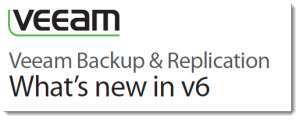Find what's new in Veeam Backup & Replication v 6.0
The upcoming Veeam Backup and Replication v. 6.0 which will be released very soon, brings some big changes at the architecture level. You might be wondering what is new?
I was covering in my blog post the beta release from VMworld Copenhagen 2011 this year. But that was just a fraction of what's announced. In fact the new Veeam 6 does innovate not only in the Backup part of the software, but also Replication, Migration, VM Copy, Restore, Indexing, Statistics and Reports. And mostly, the whole architecture has been improved and changed from centric model to deported model (or distributed model, if you want) where multiple backup proxies are handling the jobs and the Backup server acts as a “Director” of the whole BCDR infrastructure.
In fact, Veeam has released recently a complete PDF document – Veeam Backup 6 – What's New – where you can find All the detailed features of the new upcoming product. The architecture change is the one which is the most visible and most important. The new version scales up even for very large installations where the high power of the backup server is no longer necessary, since the distributed architecture with backup proxies does handle the jobs.
There is many new features announced which I already talked about, but also many of them I discovered from this PDF and some of them are just really cool and I want to share. So here are some of the new features and improvements which in my opinion are worthy to read about.
– 1 Click File Restore – feature which simplifies even more the restoration process. Through the research UI after done search for your deleted file, you are able to restore with right-click > restore, file is restored to the original location. Possibility to deleagate the file restorations to people with less elevated privileges.
 – Advanced Replication – With the new Veeam architecture in place the replication jobs runs faster (up to 10 times faster). Multiple backup proxies, each in different location, does compress the data before sending them over the WAN which results in up to 5 times less traffic over the WAN. The placement of the backup server is no longer important, since the backup/replication job is “piloted” by the backup server between the source proxy and the target proxy server.
– Advanced Replication – With the new Veeam architecture in place the replication jobs runs faster (up to 10 times faster). Multiple backup proxies, each in different location, does compress the data before sending them over the WAN which results in up to 5 times less traffic over the WAN. The placement of the backup server is no longer important, since the backup/replication job is “piloted” by the backup server between the source proxy and the target proxy server.
– Multiple TCP/IP connections – Optionally, the backup proxies can establish multiple TCP/IP connections which speeds up to 3 times the processing over WAN links but also LAN transfers.
– Traffic Throttling engine added to backup server – this throttling engine acts with global rules. The throttling rules are defined at the source/destination pair. Can prioritize or distribute evenly the bandwidth available between the backup proxies. Settings can be scheduled to change during the day of the week or hour during the day.
– Linux or Windows backup targets – Not only linux backup targets but in the v6 there is Windows backup targets, with new Windows target agent for Windows servers introduced. Those target agents are used for the traffic optimization and for the processing of updates of synthetic full backups on the backup target as well.
– Multiple vPower Servers – In fact, every backup proxy or Windows backup repository can act as a vPower NFS server and you're able to run several VMs at once directly from your backup.
– Multiple Jobs at the same time for the same VM – in fact, you're able to backup VM which is at the same time being protected by near CDP (Continuous Data Protection) in replication job. Previously you had to suspend replication job in order the backup job to happend.
– Swap files exclusions – Swap files are excluded from backups. The data blocks present in swap files are ignored when backed up and as the result the full and incrementals backup and also replication jobs are done faster.
– Metadata in v6 of Backup Files – Those Metadatas improves reading the content of backup files and as a result the speed of the backup import increased.
– Alignement of data files – 4k data alignment improves deduplication ratio when backed up to third party storage.
Source: Veeam PDF – What's new in v6
